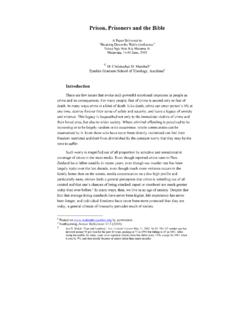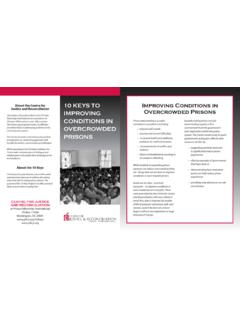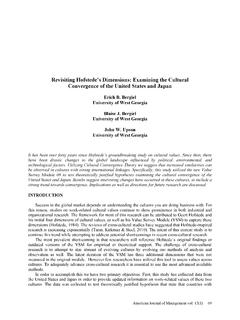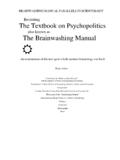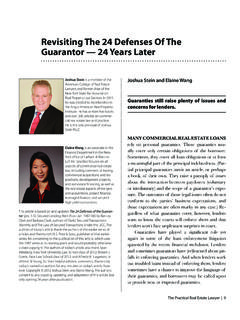Transcription of Revisiting reintegrative shaming - Restorative Justice
1 CRIMINOLOGY AOTEAROA/NEW ZEALAND 10 10 Revisiting reintegrative shaming John Braithwaite's theory of reintegrative shaming has been influential in providing a rationale for some types of conferences. It formed the basis for the system of conferencing developed by the police in Wagga Wagga, in Canberra, in Thames Valley and in the Real Justice conferences in the United Sides and elsewhere. In the following article, Allison Morris raises some concerns about the continued reliance on this theory in the practice of conferencing. Describing reintegrative shaming In this section, I try to convey the gist of Braithwaite's theory of reintegrative shaming although it is difficult to summarise a book and numerous articles in a paragraph or two.
2 There are five key areas. The entwining of guilt and shame Braithwaite sees shame and guilt as intimately entwined and suggests that, from the offender's perspective, they may be indistinguishable. This may be so. However, for me, the key issue is slightly different. It is: should conferences (or, more broadly, Restorative Justice processes) be set up to specifically induce either guilt or shame in offenders. Defining shaming Braithwaite defines shaming as 'all social processes of expressing disapproval which have the intention or effect of invoking remorse in the person being shamed and/or condemnation of others who become aware of the shaming '. What is important for Braithwaite then is 'disapproval' and 'remorse' rather than what is conventionally or popularly thought of as shame or shaming .
3 By choosing the wads 'shame' or ' shaming ' to describe the mechanisms usd for invoking remorse is, for me, more than a semantic quibble because it, in effect, also entwines shame and remorse. Also, it is apparent from this quote that Braithwaite is concerned with both the disapprover's intention and its effect on the recipient (the offender). Entwining intent and effect is also, for me, problematic. I return to both of these points later. Distinguishing stigmatic shaming and reintegrative shaming The distinction Braithwaite makes between stigmatic shaming and reintegrative shaming is crucial. Braithwaite is firmly opposed to stigmatic shaming and sees it as likely to be counter-productive.
4 reintegrative shaming , on the other hand, is seen as likely to be effective in controlling crime. It means that the offence rather than the offender is condemned and the offender is reintegrated with rather than rejected by society. The problem here is the difficulty of putting this ideal of reintegrative shaming into practice. The shame that matters Braithwaite suggests that the shame which matters most is not the shame of judges or police officers but the shame of the people we most care about. The problem here again is the difficulty of putting this into practice. Many of the examples of conferencing which have relied most heavily on Braithwaite's theory have been managed through the police. Effective delivery of shaming Braithwaite sees communitarian societies as more able to deliver both more effective shaming and more reintegrative shaming .
5 The problem here is that it is not clear that such conditions can readily be replicated in 21st century Western societies. Braithwaite acknowledges this. But we also need to explore whether or not it is possible to replicate such conditions within local communities, or even within communities of care. Concerns about putting reintegrative shaming into practice I mentioned earlier three examples of conferencing which are based on reintegrative shaming . All three have been (or are continuing to be) evaluated. A range of positive findings have emerged, especially in my comparisons between conferencing and courts. All rely heavily on police officers as facilitators. However, from the offenders' perspective, police officers are not necessarily neutral facilitators.
6 Commenting generally on police-led conferences, Richard Young writes that shaming the offender as a person might occur if participants fail to maintain the crucial distinction between the doer and the deed demanded by Braithwaite's theory or if offenders, through having their behaviour shamed, come to feel that they are shameful people. reintegrative shaming , as noted previously, demands that the offender -- the person to be shamed -- should respect the shamer or at least should acknowledge the legitimacy of the shamer's authority. There is some doubt that this exists vis a vis the police among those young people most likely to be part of a conference.
7 Positive support for the police seems to decline with age and it is likely that this is CRIMINOLOGY AOTEAROA/NEW ZEALAND 11 11 explained not only by an increase in young people's contact with the police as they grew older, but also by the nature of that contact. A surprisingly high proportion of young people report 'adversarial' contact with the police. Repeated contact with the police also has a significant negative effect on young people's perception of the police, especially if this is the only kind of contact which the young person had with them. Concerns about reintegrative shaming I focus here on four concerns commonly raised about reintegrative shaming : its failure to address structural issues, its cultural specificity, whether the key variable is the 'shamer's' intent or the actual effects of the shame on the 'shamed', and difficulties in measuring reintegrative shaming .
8 Individualising crime Rob White argues that reintegrative shaming fails to acknowledge the structural causes of youth crime or to explain how and why only certain young people are identified as 'offenders' and subsequently processed through the youth Justice system. It focuses instead on individual offenders and places responsibility for the 'choice' to offend squarely on them. However no matter how remorseful or shamed an offender might be, and no matter how welcoming the offender's communities of care might be in his or her return to the fold, if the structural causes of that offending remain untouched then reoffending seems likely. Reintegration into communities of care is insufficient if offenders (and their communities of care) remain marginalised and socially excluded.
9 However, to be fair to Braithwaite, there is no youth Justice system - irrespective of its philosophic base - which challenges the marginalisation and social exclusion. These have to be addressed through wider social, economic and educational policies. Culture and shame Braithwaite promotes shame and shaming as cultural universals. Harry Blagg, on the other hand, challenges the relevance of reintegrative shaming specifically for Aboriginals in Australia He doubts that the many displaced Aboriginals an Australia live within the kind of community required for reintegrative shaming to 'work.' Aboriginals in Australia, he suggests, tend to have loose affiliations rather than tightly knit group membership.
10 Braithwaite disputes these claims and writes that one does not have to spend long with Aboriginal people to see examples of disapproving of particular acts while treating those who commit them with great respect. I cannot comment on this one way or the other, but I suppose the issue then becomes whether or not this can be replicated within the dominant culture where many Aboriginals already have low status. Blagg also raises questions about how Aboriginals, whose pattern of experience has been harassment on the street by the police and discrimination in every-day life by the dominant culture, can realistically be expected to see the processes of shaming as resulting in reintegration within communities.
